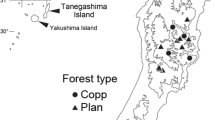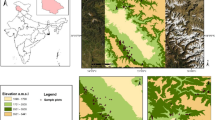Abstract
Abandonment of coppicing is one of the main reasons of diversity decline in European temperate forests. To reverse this trend, coppicing has been reintroduced in several forests, especially in areas of high conservation value. However, empirical information on the effects of coppicing on plant diversity and composition is still scarce. By comparing vegetation data from active coppices and beech-dominated high forests in the Banat region in Romania, we tested the hypothesis that coppices have a higher plant diversity and different plant species composition than high forests. Data were collected in 60 randomly placed phytosociological relevés and were analysed using linear models and multivariate methods. As expected, we found differences in understorey plant composition. Herb species with various environmental demands–sciophytes-(hemi)-heliophytes and grassland species–were more frequent in coppices whereas high forests had more vernal species and sciophytes. Coppices also had slightly greater plant diversity but did not differ in herb species richness. Our results demonstrate that coppicing has a small positive effect on plant diversity but a large effect on species composition. Coppice restoration may be especially beneficial for populations of thermophilous and non-forest species.



Similar content being viewed by others
References
Baker SC, Halpern CB, Wardlaw TJ, Crawford RL, Bigley RE, Edgar GJ, Evans SA, Franklin JF, Jordan GJ, Karpievitch Y (2015) Short-and long-term benefits for forest biodiversity of retaining unlogged patches in harvested areas. Forest Ecol Managem 353:187–195
Belote RT, Jones RH, Wieboldt TF (2012) Compositional stability and diversity of vascular plant communities following logging disturbance in Appalachian forests. Ecol Applic 22:502–516
Brooks TM, Mittermeier RA, da Fonseca GA, Gerlach J, Hoffmann M, Lamoreux JF, Mittermeier CG, Pilgrim JD, Rodrigues AS (2006) Global biodiversity conservation priorities. Science 313:58–61
Canham CD, Denslow JS, Platt WJ, Runkle JR, Spies TA, White PS (1990) Light regimes beneath closed canopies and tree-fall gaps in temperate and tropical forests. Can J Forest Res 20(5):620–631
Canullo R, Campetella G, Mucina L, Chelli S, Wellstein C, Bartha S (2011) Patterns of Clonal Growth Modes Along a Chronosequence of Post-Coppice Forest Regeneration in Beech Forests of Central Italy. Folia Geobot 46:271–288
Ciocarlan V (2000) Flora ilustrata a Romaniei – Pterydophyta si Spermatophyta. Editura Ceres, Bucuresti, 1138 pp
Chytrý M, Tichý L, Holt J, Botta-Dukát Z (2002) Determination of diagnostic species with statistical fidelity measures. J Veg Sci 13:79–90
Chytrý M, Kučera T, Kočí M, Grulich V, Lustyk P (eds) (2010) Katalog biotopů České republiky. Ed. 2. Agentura ochrany přírody a krajiny ČR, Praha
Corney PM, Kirby KJ, Le Duc MG, Smart SM, McAllister HA, Marrs RH (2008) Changes in the field-layer of Wytham Woods – assessment of the impacts of a range of environmental factors controlling change. J Veg Sci 19:287–298
Decoq G, Aubert M, Dupont F, Alard D, Saguez R, Wattez-Franger A, de Foucault B, Delelis-Dusollier A, Bardat J (2004) Plant diversity in a managed temperate deciduous forest: understorey response to two sivicultural systems. J Appl Ecol 41:1065–1079
Del Tredici P (2001) Sprouting in temperate trees: a morphological and ecological review. Bot Rev 67:121–140
European Forest Institute (2013) Implementing criteria and indicators for sustainable forest management in Europe. 132 pp
European Commission (2011) Our life insurance, our natural capital: an EU biodiversity strategy to 2020. Available at http://ec.europa.eu/environment/nature/biodiversity/comm2006/pdf/EP_resolution_april2012.pdf
Fares S, Mugnozza GS, Corona P, Palahí M (2015) Sustainability: five steps for managing Europe's forests. Nature 519:407–409
Fartmann T, Müller C, Poniatowski D (2013) Effects of coppicing on butterfly communities of woodlands. Biol Conservation 159:396–404
Gesce D. (2013) Historie českých komunit v Rumunsku. Praha. 464 pp
Gilliam FS (2007) The ecological significance of the herbaceous layer in temperate forest ecosystems. BioScience 57:845–858
Graae BJ, Heskjær VS (1997) A comparison of understorey vegetation between untouched and managed deciduous forest in Denmark. Forest Ecol Managem 96:111–123
Hédl R, Kopecký M, Komárek J (2010) Half a century of succession in a temperate oakwood: from species-rich community to mesic forest. Diversity & Distrib 16:267–276
Jones A, Montanarella L, Jones E (eds) (2005) Soil atlas of Europe. European Soil Bureau Network, Luxembourg. 128 pp
Kondracki J, Bohn U (2003) Klimatische Gliederung Europas, pp 75–78. In Bohn U, Neuhäusl R et al. Karte der natürlichen Vegetation Europas. Teil l: Erläuterungstext
Maděra P, Kovář P, Romportl D, Buček A (eds) (2014) Czech villages in Romanian Banat: landscape, nature and culture. Mendel University in Brno. 348 pp
Matula R, Damborská L, Nečasová M, Geršl M, Šrámek M (2015) Measuring biomass and carbon stock in resprouting woody plants. PLOS ONE 10:e0118388
Matula R, Svátek M, Kůrová J, Úradníček L, Kadavý J, Kneifl M (2012) The sprouting ability of the main tree species in Central European coppices: implications for coppice restoration. Eur J Forest Res 131:1501–1511
Mölder A, Bernhardt-Römermann M, Schmidt W (2008) Herb-layer diversity in deciduous forests: raised by tree richness or beaten by beech? Forest Ecol Managem 256:272–281
Müllerová J, Hédl R, Szabó P (2015) Coppice abandonment and its implications for species diversity in forest vegetation. Forest Ecol Managem 343:88–100
Müllerová J, Szabó P, Hédl R (2014) The rise and fall of traditional forest management in southern Moravia: a history of the past 700 years. Forest Ecol Managem 331:104–115
Nocentini S (2009) Structure and management of beech (Fagus sylvatica L.) forests in Italy. iForest 2:105–113
Oksanen J et al. (2013) vegan: community ecology package. R package version 2.0–7. Available at http://cran.r-project.org/package=vegan
R Development Core Team (2013) R: a language and environment for statistical computing. R Foundation for Statistical Computing, Vienna, Austria. Available at http://www.r-project.org
Roberts MR, Gilliam FS (2003) Response of the Herbaceous Layer to Disturbance in Eastern Forests. The herbaceous layer in forests of eastern North America (ed. F.S. Gilliam). Oxford University Press
Šebesta J, Šamonil P, Lacina J, Oulehle F, Houška J, Buček A (2011) Acidification of primeval forests in the Ukraine Carpathians: Vegetation and soil changes over six decades. Forest Ecol Managem 262:1265–1279
Spitzer L, Konvička M, Beneš J, Tropek R, Tuf IH, Tufová J (2008) Does closure of traditionally managed open woodlands threaten epigeic invertebrates? Effects of coppicing and high deer densities. Biol cons 141:827–837
Šrámek M, Volařík D, Ertas A, Matula R (2015) The effect of coppice management on the structure, tree growth and soil nutrients in temperate Turkey. J Forest Sci 61:27–34
Svátek M, Matula R (2015) Fine-scale spatial patterns in oak sprouting and mortality in a newly restored coppice. Forest Ecol Managem348:117–123
Szabó P (2009) Open woodland in Europe in the Mesolithic and in the Middle Ages: Can there be a connection? Forest Ecol Managem 257:2327–2330
Szabó P (2010) Driving forces of stability and change in woodland structure; a case study from the Czech lowlands. Forest Ecol Managem 259:650–656
Tichý L (2002) JUICE, software for vegetation classification. J Veg Sci 13:451–453
Tistea D (1974) Temperatura aerului. In Atlasul republicii socialiste Romania. Maps in scale 1:1,500,000 and 1:3,000,000
Van Calster H, Baeten L, De Schrijver A, De Keersmaeker L, Rogister JE, Verheyen K, Hermy M (2007) Management driven changes (1967–2005) in soil acidity and the understorey plant community following conversion of a coppice-with-standards forest. Forest Ecol Managem 24:258–271
Vera FWM (2000) Grazing Ecology and Forest History. CABI, Wallingford
Vild O, Roleček J, Hédl R, Kopecký M, Utinek D (2013) Experimental restoration of coppice-with-standards: Response of understorey vegetation from the conservation perspective. Forest Ecol Managem 310:234–241
Vockenhuber EA, Scherber C, Langenbruch C, Meißner M, Seidel D, Tscharntke T (2011) Tree diversity and environmental context predict herb species richness and cover in Germany's largest connected deciduous forest. Perspect Pl Ecol Evol Syst 13:111–119
Volařík et al. (2017) Variation in canopy openness among main structural types of woody vegetation in a traditionally managed landscape. Folia Geobot (this issue)
Wohlgemuth T, Bürgi M, Scheidegger Ch, Schütz M (2002) Dominance reduction of species through disturbance – a proposed management principle for central European forests. Forest Ecol Managem 166:1–15
Acknowledgements
We thank Péter Szabó and Jan W. Jongepier for language revisions and two anonymous reviewers for valuable comments on a previous version of the manuscript. This study was funded by project OPVK CZ.1.07/2.3.00/20.0004 of the Ministry of Education, Youth and Sports and by the project ‘Involvement of the Czech Republic in the research of the European Forest Institute (EFI)’ and by the project IGA LDF_VT_2016014, Comparison of the stand structure and plant diversity of the active coppices Eastern and Western Europe.
Author information
Authors and Affiliations
Corresponding author
Appendix 1
Appendix 1
Rights and permissions
About this article
Cite this article
Šebesta, J., Maděra, P., Řepka, R. et al. Comparison of vascular plant diversity and species composition of coppice and high beech forest in the Banat region, Romania. Folia Geobot 52, 33–43 (2017). https://doi.org/10.1007/s12224-016-9279-3
Received:
Accepted:
Published:
Issue Date:
DOI: https://doi.org/10.1007/s12224-016-9279-3




